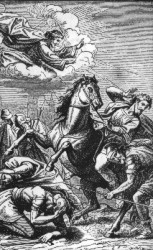
The Conversion of Saint Paul
|

The Conversion of Saint Paul![]() January 25th
January 25th ![]()
We read in the Acts of the Apostles three accounts of the conversion of St. Paul (ix, 1-19; xxii, 3-21; xxvi, 9-23) presenting some slight differences, which it is not difficult to harmonize and which do not affect the basis of the narrative, which is perfectly identical in substance. See J. Massie, "The Conversion of St. Paul" in "The Expositor", 3rd series, X, 1889, 241-62. Sabatier agreeing with most independent critics, has well said (L'Apotre Paul, 1896, 42): These differences cannot in any way alter the reality of the fact; their bearing on the narrative is extremely remote; they do not deal even with the circumstances accompanying the miracle but with the subjective impressions which the companions of St. Paul received of these circumstances. . . . To base a denial of the historical character of the account upon these differences would seem therefore a violent and arbitrary proceeding." All efforts hitherto made to explain without a miracle the apparition of Jesus to Paul have failed. Naturalistic explanations are reduced to two: either Paul believed that he really saw Christ, but was the victim of an hallucination, or he believed that he saw Him only through a spiritual vision, which tradition, recorded in the Acts of the Apostles, later erroneously materialized. Renan explained everything by hallucination due to disease brought on by a combination of moral causes such as doubt, remorse, fear, and of physical causes such as ophthalmia, fatigue, fever, the sudden transition from the torrid desert to the fresh gardens of Damascus, perhaps a sudden storm accompanied by lightning and thunder. All this combined, according to Renan's theory, to produce a cerebral commotion, a passing delirium which Paul took in good faith for an apparition of the risen Christ.

The other partisans of a natural explanation while avoiding the word hallucination, eventually fall back on the system of Renan which they merely endeavour to render a little less complicated. Thus Holsten, for whom the vision of Christ is only the conclusion of a series of syllogisms by which Paul persuaded himself that Christ was truly risen. So also Pfleiderer, who however, causes the imagination to play a more influential part: "An excitable, nervous temperament; a soul that had been violently agitated and torn by the most terrible doubts; a most vivid phantasy, occupied with the awful scenes of persecution on the one hand and on the other by the ideal image of the celestial Christ; in addition the nearness of Damascus with the urgency of a decision, the lonely stillness, the scorching and blinding heat of the desert -- in fact everything combined to produce one of those ecstatic states in which the soul believes that it sees those images and conceptions which violently agitate it as if they were phenomena proceeding from the outward world" (Lectures on the influence of the Apostle Paul on the development of Christianity, 1897, 43). We have quoted Pfleiderer's words at length because his "psychological" explanation is considered the best ever devised. It will readily be seen that it is insufficient and as much opposed to the account in the Acts as to the express testimony of St. Paul himself. (1) Paul is certain of having "seen" Christ as did the other Apostles (I Cor., ix, 1); he declares that Christ "appeared" to him (I Cor., xv, 8) as He appeared to Peter, to James, to the Twelve, after His Resurrection. (2) He knows that his conversion is not the fruit of his reasoning or thoughts, but an unforeseen, sudden, startling change, due to all-powerful grace (Gal., i, 12-15; I Cor., xv, 10). (3) He is wrongly credited with doubts, perplexities, fears, remorse, before his conversion. He was halted by Christ when his fury was at its height (Acts, ix, 1-2); it was "through zeal" that he persecuted the Church (Phil., iii, 6), and he obtained mercy because he had acted "ignorantly in unbelief" (I Tim., i, 13). All explanations, psychological or otherwise, are worthless in face of these definite assertions, for all suppose that it was Paul's faith in Christ which engendered the vision, whereas according to the concordant testimony of the Acts and the Epistles it was the actual vision of Christ which engendered faith.
The Catholic Encyclopedia, Volume XI
Nihil Obstat, February 1, 1911, Remy Lafort, S.T.D., Censor
Imprimatur. +John Cardinal Farley, Archbishop of New York
|
|